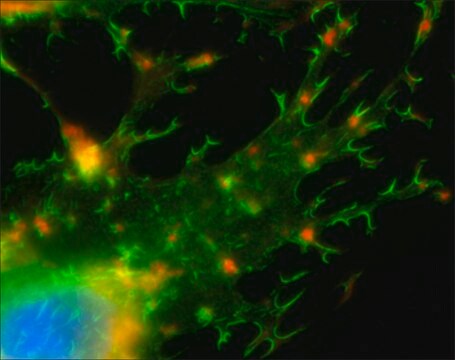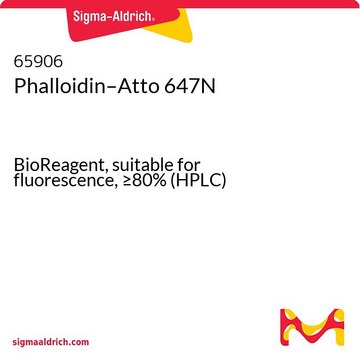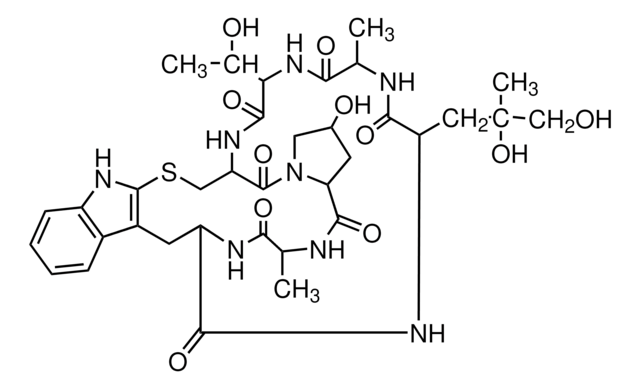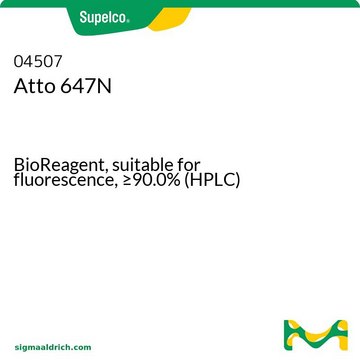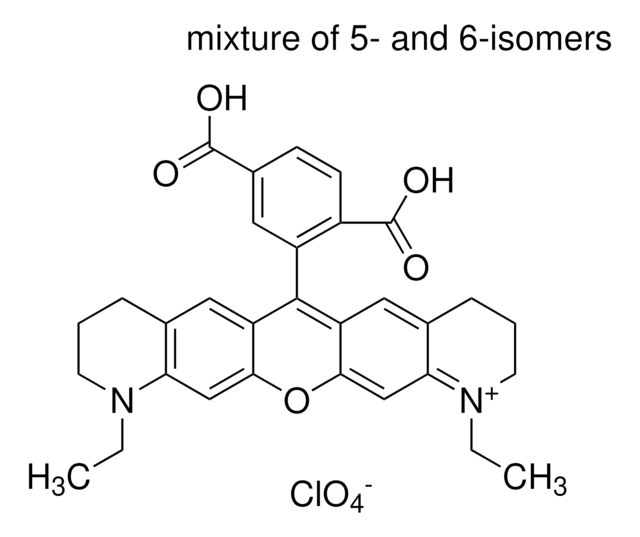94072
Phalloidin–Atto 565
suitable for fluorescence, ≥80.0% (HPLC)
Faça loginpara ver os preços organizacionais e de contrato
About This Item
Código UNSPSC:
12352108
NACRES:
NA.32
Produtos recomendados
Ensaio
≥80.0% (HPLC)
Formulário
solid
peso molecular
Mw 1394 g/mol
fabricante/nome comercial
ATTO-TEC GmbH
λ
in methanol
Absorção UV
λ: 562.0-568.0 nm Amax
adequação
suitable for fluorescence
temperatura de armazenamento
−20°C
Descrição geral
Atto 565 is a novel fluorescent label that belongs to the class of Rhodamine dyes. It shows a strong absorption, high fluorescence quantum yield, high thermal and photostability, and a very little triplet formation. Atto 565 consists of a mixture of two isomers with practically identical optical absorption and emission Phalloidin is a fungal toxin isolated from the poisonous mushroom Amanita phalloides. Its toxicity is attributed to the ability to bind F actin in liver and muscle cells. As a result of binding phalloidin, actin filaments become strongly stabilized. Phalloidin has been found to bind only to polymeric and oligomeric forms of actin, and not to monomeric actin. The dissociation constant of the actin-phalloidin complex has been determined to be on the order of 3 x 10-8. Phalloidin differs from amanitin in rapidity of action; at high dose levels, death of mice or rats occurs within 1 or 2 hours. Fluorescent conjugates of phalloidin are used to label actin filaments for histological applications. Some structural features of phalloidin are required for the binding to actin. However, the side chain of amino acid 7 (g-d-dihydroxyleucine) is accessible for chemical modifications without appreciable loss of affinity for actin.
find more information here
find more information here
Código de classe de armazenamento
11 - Combustible Solids
Classe de risco de água (WGK)
WGK 3
Ponto de fulgor (°F)
Not applicable
Ponto de fulgor (°C)
Not applicable
Escolha uma das versões mais recentes:
Já possui este produto?
Encontre a documentação dos produtos que você adquiriu recentemente na biblioteca de documentos.
Os clientes também visualizaram
Recombinant Extracellular Matrix Protein Fragments Support Human Embryonic Stem Cell Chondrogenesis.
Aixin Cheng et al.
Tissue engineering. Part A, 24(11-12), 968-978 (2017-12-28)
We previously developed a 14-day culture protocol under potentially GMP, chemically defined conditions, to generate chondroprogenitors from human embryonic stem cells (hESCs). In vivo work has confirmed the cartilage repair capacity of these cells in a nude rat osteochondral defect
Silke Rothenbusch-Fender et al.
Biology open, 6(12), 1876-1888 (2017-11-11)
During
A Béduer et al.
Acta biomaterialia, 76, 71-79 (2018-06-09)
We present a 3D-printing technology allowing free-form fabrication of centimetre-scale injectable structures for minimally invasive delivery. They result from the combination of 3D printing onto a cryogenic substrate and optimisation of carboxymethylcellulose-based cryogel inks. The resulting highly porous and elastic
PALM and STORM. Unlocking live-cell super-resolution.
Henriques, R.; Griffiths, C.; Hesper Rego, E.; Mhlanga, Musa M.
Biopolymers, 95(5), 322-331 (2011)
Direct stochastic optical reconstruction microscopy with standard fluorescent probes.
van de Linde, S.; et al.
Nature Protocols, 6(7), 991-1009 (2011)
Conteúdo relacionado
Atto dyes are a series of fluorescent dyes that meet the critical needs of modern fluorescent technologies
Nossa equipe de cientistas tem experiência em todas as áreas de pesquisa, incluindo Life Sciences, ciência de materiais, síntese química, cromatografia, química analítica e muitas outras.
Entre em contato com a assistência técnica